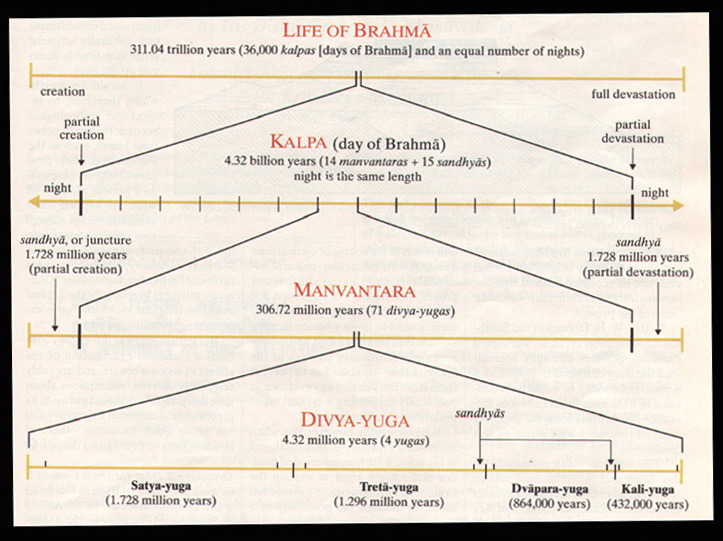Vedic time ... 
Source: http://www.mcremo.com/vedic.htm, http://en.wikipedia.org/wiki/Hindu_units_of_measurement
Time from an ancient point of view ...
"The time concept of modern archeology, and modern anthropology in general, resembles the general cosmological-historical time concept of Europe's Judeo-Christian culture. Differing from the cyclical cosmological-historical time concepts of the early Greeks in Europe, and the Indians and others in Asia, the Judeo-Christian cosmological-historical time concept is linear and progressive.
Hindu historical literatures, particularly the Puranas and Itihasas, place human existence in the context of repeating time cycles called yugas and kalpas, lasting hundreds of millions of years. During this entire time, according to the Puranic accounts, humans coexisted with creatures in some ways resembling the earlier toolmaking hominids of modern evolutionary accounts." 1

Imgae credit http://www.mcremo.com/vedic.htm
"Each day of Brahma is divided into 14 manvantara periods, each one lasting 71 yuga cycles. Preceding the first and following each manvantara period is a juncture (sandhya) the length of a Satya-yuga (1,728,000 years). Typically, each manvantara period ends with a partial devastation. According to Puranic accounts, we are now in the twenty-eighth yuga cycle of the seventh manvantara period of the present day of Brahma."1
Our current date ...
Currently, 50 years of Brahma have elapsed and we are in the first Day of the 51st year. This Brahma's day, Kalpa, is named as ShvetaVaraha Kalpa. Within this Day, six Manvantaras have already elapsed and we are in the seventh Manavatara, named as - Vaivasvatha Manvantara (or Sraddhadeva Manavatara). Within the Vaivasvatha Manavantara, 27 Mahayugas (4 Yugas together is a Mahayuga), and the Krita, Treta and Dwapara Yugas of the 28th Mahayuga have elapsed. We are in the Kaliyuga of the 28th Mahayuga. This Kaliyuga began in the year 3102 BC in the proleptic Julian Calendar. Since 50 years of Brahma have already elapsed, we are in the second Parardha, also called as Dvithiya Parardha.
The time elapsed since the current Brahma has taken over the task of creation can be calculated as
432000 x 10 x 1000 x 2 = 8.64 Billion Years (2 Kalpa(day and night) )
8.64 x 109 x 30 x 12 = 3.1104 Trillion Years (1 year of Brahma)
3.1104 x 1012 x 50 = 155.52 Trillion Years (50 years of Brahma)
(6 x 71 x 4320000 ) + 7 x 1.728 x 106 = 1.852 billion years elapsed in first six Manvataras, and Sandhi Kalas in the current Kalpa
27 x 4320000 = 116.64 million years elapsed in first 27 Mahayugas of the current Manvantara
1.728 x 106 + 1.296 x 106 + 864000 = 3.888 million years elapsed in current Mahayuga
3102 + 2011 = 5113 years elapsed in current Kaliyuga.
So the total time elapsed since current Brahma is
155.52 x 1012 + 1.973x109 + 0.00012053302 = 155,521,972,949,113 Years
The current Kali Yuga began at midnight 17 February / 18 February in 3102 BC in the proleptic Julian calendar.
Source: http://www.mcremo.com/vedic.htm, http://en.wikipedia.org/wiki/Hindu_units_of_measurement
1. Excerpt from: Cremo, Michael A. (1999) "Puranic Time and the Archeological Record." Chapter 3 in Time and Archaeology: Vol. 37,
One World Archaeology Series, edited by Tim Murray, Routledge, London
Further reading: http://en.wikipedia.org/wiki/Hindu_units_of_measurement